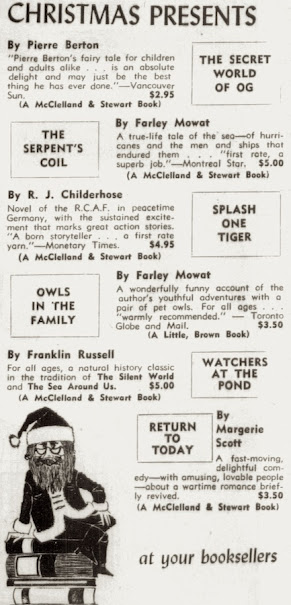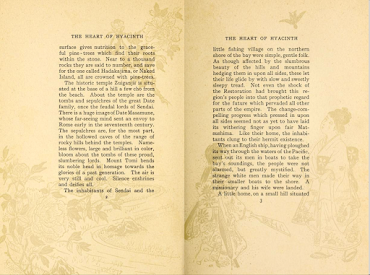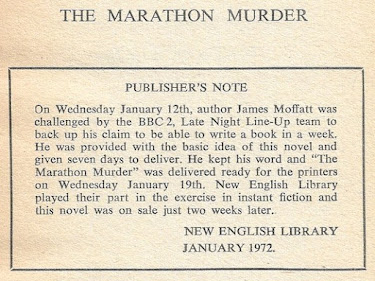Neighbours
Laurali Wright [L.R. Wright]
Toronto: Macmillan of Canada, 1979
258 pages
There's so much wrong with this jacket illustration. Set aside the eyes for a moment and focus on the houses. They're nearly identical, right? The one on the left is a mirror image of the other two, yet the neighbours in Neighbours live in dwellings of differing designs separated by spacious lawns. The figure standing before the open garage in Clement Clarke Moore sleeping cap does not feature.
Returning to the eyes: I thought they belonged to a man, but Neighbours is a novel about three women. Betty Coutts is the first we meet. She lives with husband Jack and daughter Heather in a Calgary subdivision. As a travelling salesman, Jack is rarely present, which leaves young Heather in a precarious position. The extent to which Jack recognizes his daughter's peril – I do not exaggerate in using that word – is unclear. Could be he's in denial.
It's apparent from the start that Betty is suffering from a serious mental illness. She's unable to work and spends much of her day in bed eating candy. The house is a worsening filthy mess, which prompts Jack, who has returned home from yet another sales trip, to spray the kitchen with a garden hose. This early scene is uncharacteristic; Jack is otherwise sensitive and patient regarding his wife's mental health. It's due to his efforts that Betty has weekly meetings with a psychologist named Jessup.
For a time, it's suggested – by the doctor, at least – that Betty is making progress. At Jessup's urging, she makes an effort to make new friends, targeting two next-door neighbours. Elderly Poinsettia, lives in the house to the left. Betty insists on calling her Bertha, which Poinsettia quite likes. Sheila, to the right, lives in the house Betty considers the most beautiful on the block.
Both women have problems of their own. Bertha, who lives to garden, struggles with severe arthritis. She fights worsening pain and a son and daughter-in-law who want her to give up her home and come live in theirs. Sheila's problem is worse still. Minutes before Betty's intrusion in her life – it is very much an intrusion – husband Ed revealed that he'd been having an affair. Sheila's reaction to the infidelity amounts to the strongest writing of the novel. If you read nothing else from the novel, read this.
Neighbours was a Search-for-a-New-Alberta-Novelist winner. Pauline Gedge, Andre Tom MacGregor, Fred Stenson, Jan Truss, and Betty Wilson were fellow honourees. In reading reviews from the time, I came upon three in the Montreal Gazette, my hometown paper. Published on 1 June 1979, the first belongs to Zonia Keywan:
The second is by Walter J. Traprock, whose name I can find nowhere outside the newspaper's 3 November 1979 edition. He butts against Zonia Keywan, feeding Western alienation:
Laurali (Bunny) Wright is the winner is of the fourth Search-For-A-New-Alberta-Novelist competition. Despite this dubious distinction, she writes well, and if her first novel, Neighbours, has problems, it also has considerable promise.
I have no idea why the Gazette saw fit to review the Macmillan edition twice. Change in editors? Poor memory? Drunkenness?
The third, published on 11 June 1980, was occasioned by the novel's paperback release. Written by the legendary Marion McCormick, it's the shortest and the most amusing:
All too often, young writers write the same heavily autobiographical story: the hero heroine – always the most sensitive kid on the school bus – suffers in a provincial hamlet populated by Yahoos until he she can break away and write a novel about it.
Neighbours is something else; a well-plotted suspense story involving three families who live on a Calgary street. The author achieves a mixture of pathos and menace that sticks in the mind.
I side with Marion McCormick.
Macmillan's dust jacket, flaps included, focus on Betty, selling the novel of one woman's hellish decent into madness. I see it as something much more. Neighbours is about neighbours. Betty brings Bertha and Sheila into the story. Again, it is a novel about three women; it is a "Chilling Story" only because the struggles each face are so consuming that they can do nothing to help one another.
It sticks in the mind.
Object and Access: The jacket illustration is credited to Martin Springett. Richard Miller is credited with the design.
As "L.R. Wright," Laurali Wright – Rose was her middle name – went on to become the foremost Canadian mystery writer of her time. Wright's fourth book, The Suspect, was recognized in the United States with the 1986 Edgar for Best Novel. This being Canada, it is unsurprising that the Macmillan edition enjoyed nothing more than a single printing. In 1980, Signet published the novel in paperback. I've never seen a copy.
Neighbours is sadly typical of Macmillan's 'seventies output in that it is nearly impossible to read without cracking the spine. Collectors of Alice Munro and Robertson Davies know of what I speak. My copy was purchased two years ago in Montreal at S.W. Welch. Price: $5.00. The previous reader or readers broke its spine twice. I take pride in having been so careful as to not increase that number.
Mine is the only copy I've ever seen in person, but there are others – not many – being offered online. At US$13.95, a Nova Scotia bookseller has listed one as "very tight unread/unopened." Another bookseller shares this disturbing image:
At US$100, the standout is a Very Good copy signed by the author.
That is the one to buy. Careful with the spine!
















































